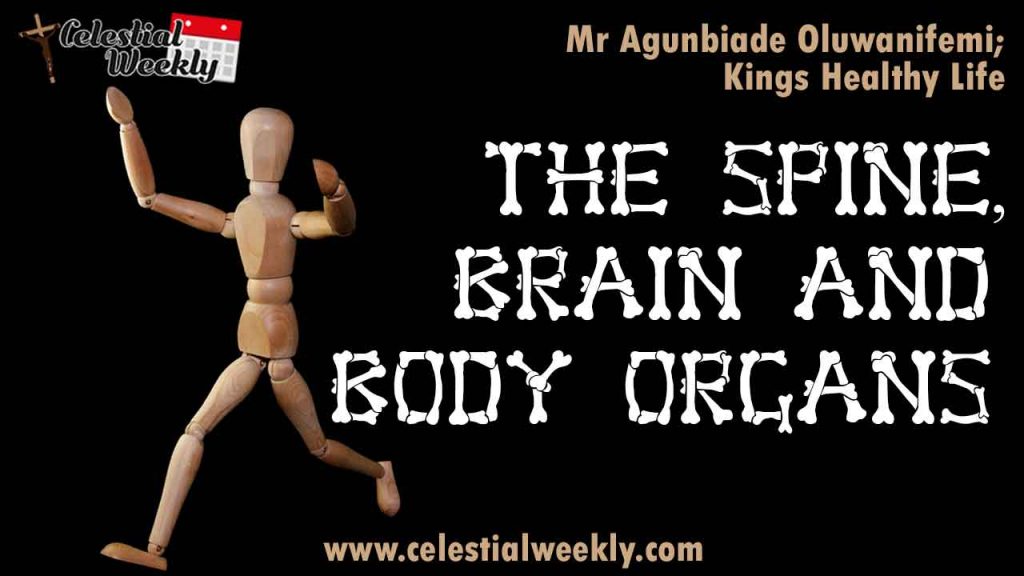The Spine, The Brain and Body Organs
What should you know about the spine?
The spine (or backbone) runs from the base of the skull to the pelvis. It serves as a pillar to support the body’s weight and to protect the spinal cord. There are three natural curves in the spine that give it an “S” shape when viewed from the side. These curves help the spine withstand great amounts of stress by providing a more even distribution of body weight.
The spine is made up of a series of bones that are stacked like blocks on top of each other with cushions called discs in between to help absorb shock/load.
The spine is divided into three regions:
- Cervical spine — the cervical spine (or neck) is the uppermost part of the spine. There are seven vertebrae within the cervical spine, numbered C1 to C7 from top to bottom.
- Thoracic spine — there are 12 vertebrae (T1 to T12) in the chest section.
- Lumbar spine — the lumbar spine (or lower back) usually consists of five vertebrae numbered L1 to L5.
Below the lumbar spine is a large bone called the sacrum. The sacrum actually consists of several vertebrae that fuse together during a baby’s development in the womb. Below the sacrum is a small bone called the coccyx (or tailbone), which another specialized bone is created by the fusion of several smaller bones during development.
- Sacrum – the main function of the sacrum is to connect the spine to the hip bones (iliac). There are five sacral vertebrae, which are fused together. Together with the iliac bones, they form a ring called the pelvic girdle.
- Coccyx region – the four fused bones of the coccyx or tailbone provide attachment for ligaments and muscles of the pelvic floor.
The spine is sometimes discussed by parts: bones (and joints), discs, nerves, and soft tissues (ligaments, tendons, muscles).
Larger amount of blood used by the body are produce from the bone marrow in the spine Roughly 80 percent. Also the spine posses the mechanism called natural healing power consisting of BLOOD, NERVES, ENERGY AND HORMONE.
BRAIN AND SPINE
The brain is a soft, spongy mass of nerve cells and supportive tissue. It has three major parts: the cerebrum, the cerebellum, and the brain stem. The parts work together, but each has special functions.
The spinal cord is made up of bundles of nerve fibers. It runs down from the brain through a canal in the center of the bones of the spine. These bones protect the spinal cord. Like the brain, the spinal cord is covered by the meninges and cushioned by cerebrospinal fluid.
Spinal nerves connect the brain with the nerves in most parts of the body. Other nerves go directly from the brain to the eyes, ears, and other parts of the head. This network of nerves carries messages back and forth between the brain and the rest of the body.
Also the brain and spinal cord form the central nervous system. This complex system is part of everything we do. It controls the things we choose to do — like walk and talk — and the things our body does automatically — like breathe and digest food. The central nervous system is also involved with our senses — seeing, hearing, touching, tasting, and smelling — as well as our emotions, thoughts, and memory.
THE RELATIONSHIP BETWEEN YOUR SPINE AND ORGANS
By understanding the relationship between the spine and certain organs, you’ll better understand the cause of several health-related issues, both physical and psychological.
The spine is our support beam, and because of it we are able to perform our daily activities. Each vertebra has a specific task, and all of them together protect the central nervous system (made up of the brain, nerves and spinal cord). In this article I would be talking about the truly interesting relationship between your spine and organs. Keep reading
CERVICAL SPINE
C1 affect thd blood supply to the head, pituitary gland, scalp, bones of the face, brain, inner and middle ear and sympathetic nervous system.
Problem
Headaches, nervousness, insomnia, head colds, high blood pressure, migraine, headaches, nervous breakdown, amnesia, chronic tiredness, dizziness.
C2 the eye, optic nerves, auditory nerves, sinuses mastoid bones, tongue and forehead
Problem
Sinus trouble, allergies, pain around the eyes earache fainting spells, certain cases of blindness, crossed eyes, deafness
C3 cheeks outer ear, face bones teeth and trifacial nerves
Problem
Neuralgia, neuritis, acne or pimples, eczema
C4 nose, lips mouth, and eustachain tube
Problem
Hay fever, runny nose, hearing loss, adenoids
C5 vocal cords, neck glands and pharynx
Problem
Laryngitis, hoarsenness, throat conditions such as sore throat or quinsy
C6 neck muscles, shoulders and tonails
Problem
Stiff neck pain in the upper arm, tonsilitis, chronic cough, croup
C7 the thyroid gland, bursae in the shoulders and elbows
Problem
Bursitis, colds, thyroid condition
THORASIC SPINE
T1 arms from the elbows down, including hands, wrist, and fingers, esophagus and trachea
Problem
Asthma, cough, difficult breathing, shortness of breath, pakn in lower arms and hands
T2 the heart, including its valves and covering, and coronary arteries
Problem
Functinal heart condition and certain chest condition
T3 lungs,branchail tubes, pleura, chest and breast
Problem
Bronchitis pleurisy, pneumonia congestion influenza. 1l1
LUMBAR SPINE
BACK PAIN, A COMMON SPINE PROBLEM
Back pain is so common that it no longer surprises us. It could be caused by sitting in front of a computer for hours, sleeping wrongly or lifting heavy objects etc.
DID YOU KNOW!
Back pain is among the most common reason for a physician visit – in fact, approximately 80% of Americans will suffer from this condition at some point during their lives.
Back pain is also a leading cause behind disability claims in the United States.
Most back pain, approximately 80%, doesn’t require medical treatment and typically subsides in one to two months. (If, however, back pain is persistent or acute, it’s recommended you seek medical attention.)
The most common cause of back pain and spinal cord trauma is car accidents.
Backbones are surprisingly strong, however, and they can sustain the weight and pressure of hundreds of kilograms.
The spine has an excellent memory, and as such, it’s recommended that you take care to provide it with proper support from a young age. Controlling your posture, engaging in strengthening the back muscles, as well as stretching are all beneficial to the long-term health of your spine.
The spine is truly fascinating, but while its complexity interests us, it’s also one reason so many different spinal conditions exist. If you’re suffering from back pain beyond occasional stiffness and muscle stress, it’s recommended you consult your physician to see if a visit to a spinal specialist.
11 WAYS TO INDULGE YOUR SPINE
- Make exercise a lifestyle
- Engage your mind
- Reevaluate your sitting posture
- Go for a walk to help support your spine
- Soothe your pain with heat therapy
- Match your pillow to your sleeping position
- Chose your food wisely
- Exercise in the water
- Treat yourself to massage therapy
- Resolve to quit smoking
- Lift correctly
Knowing fully all of these above educative pieces of health information it would give the mind an alarm toward proper spine care and attention.
To know more about your spine and also have a spine massage/ therapy







